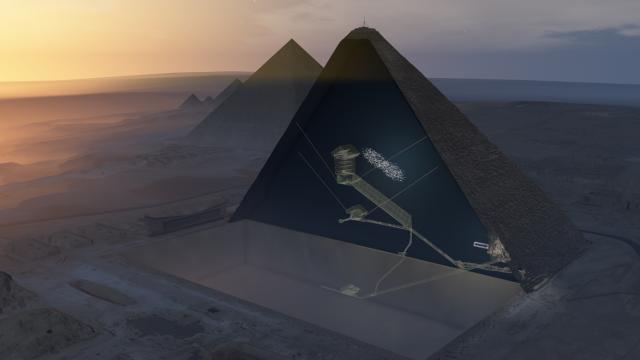A International team of scientists have found what could be a 30 metre long hidden room in the Great Pyramid of Giza – using particle physics. And finding out what exactly is inside will be done with augmented reality, and a tiny drone robot.
What a time to be alive.
Robots, augmeneted reality – sure, sure, fine. But particle physics? Yep, really. Here’s how it works.
Muons are elementary particles that sound like something straight out of a sci-fi movie – they fall on our planet at the speed of light from deep space, the result of interactions of cosmic rays with the atoms in the upper atmosphere.
And they can move through solid objects.
By working out the trajectories of muons, we can “see” inside solid objects, and the spaces between them.
The researchers describe the process as “similar to X-rays which can penetrate the body and allow bone imaging, these elementary particles can keep a quasi-linear trajectory while going through hundreds of meters of stone before decaying or being absorbed.”
Mehdi Tayoubi from the HIP Institute in France and Kunihiro Morishima from Nagoya University in Japan led the study, and while they won’t confirm that the uncovered “void” is a room, they do believe the space is “constructed”.
Originally over 140 metres high, Khufu’s pyramid was built during the Egyptian Fourth Dynasty (c. 2613 to 2494 BC) by the Pharaoh Khufu (also known as Cheops), who reigned from 2509 to 2483 BC.
As well as the “Grand Gallery” – a sloping hallway 8 metres high and 45 metres long, we know for sure that there are two finished rooms inside the pyramid (the chambers for the King and the Queen), and there is a third room that was never finished. There’s also the original main entrance, and a tunnel crated in AD 820 – which is how tourists enter the pyramid today.
But we still don’t know everything that is inside the Great Pyramid. There’s no blueprints. And discovering everything it is hiding, without damaging it, it super tricky.
The idea of using muons to explore the pyramid isn’t new – archeologist Luis Alvarez was talking about it back in the 60s – but we didn’t have the technology to pull it off. Now we do.
“Muography” is being used to explore volcanoes, discover caves – and check out Roman and Mayan ruins, so it makes sense to use it on Khufu’s pyramid, too. Last year they discovered a corridor above the main entrance using this method.
But rather than take the word of muons alone, a whole team of experts were brought in to work out what the researchers had found. They had three teams, with three different methods for detecting muons.
Nagoya University used nuclear emulsion films for 3D tracking. Alternative Energies and Atomic Energy Commission from France used “scintillator hodoscopes” to detect particles. KEK High Energy Accelerator Research Organisation used gas-based detectors.
A consensus was reached: yes, there is a big space in there. The researchers won’t use the word “chamber” – but they won’t rule one out either. There is a very real possibility it could have 5,000 year old artifacts inside. Or it could have nothing.
Speaking to Gizmodo Australia, Dr Jana Jones – a Research Fellow in the Department of Ancient History at Macquarie University, basically says we shouldn’t be jumping to conclusions.
“Firstly, we have to dismiss reports of a ‘chamber’ – or ‘secret chamber’. The team of the ScanPyramids project refer to it as a ‘void’, about 30m long directly above the Grand Gallery,” Dr Jones explains.
“The presence of a large cavity in this location suggests that it may have been involved in the construction of the Grand Gallery, which if true, would demolish theories that the pyramid was built using an internal ramp to raise blocks of stone to the upper part of the pyramid.”
Dr Jones points to the previous 2002 supposed ‘air shaft’ exploration, which happened “with much fanfare yet yielded
nothing. Similarly, Dr Jones says, the presence of a secret chamber in the tomb of Tutankhamun is to date still unresolved.
“It is far to early to jump to conclusions without further exploration,” Dr Jones advises. “The mystery of the pyramids remains.”
But the plan to solve this mystery is underway – by sending a robot inside. Jean-Baptiste Mouret from ScanPyramids, the overaching project responsible for this discovery, is working on a drone-like robot that can squeeze into the void and document what’s in there. But they still need permission from the Egyptian Council of Antiquities. And that’s not easy.
[Nature]
